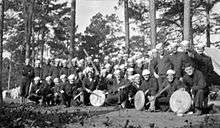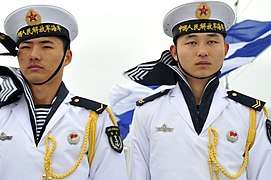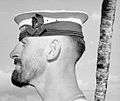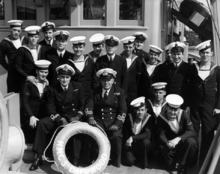Sailor cap
A sailor cap is a round, flat visorless hat worn by sailors in many of the world's navies. A tally, an inscribed black silk ribbon, is tied around the base which usually bears the name of a ship or a navy. Many navies (e.g. Germany) tie the tally at the rear of the cap and let the two ends hang down to the shoulders as decorative streamers. In the Royal Navy the tally is tied off in a bow over the left ear and in the early 20th century it was customary when going on shore leave to tie a small coin in the bow to make it stand out. In wartime, as a security measure, many navies replace the name of the ship with a generic title (e.g. "HMS" = "His/Her Majesty's Ship" in the Royal Navy or "South African Navy"). The cap may be further embellished with a badge, cockade or other accessory. Visorless caps of this kind began to be worn in the mid 19th century.
The more rigid type of sailor hat with a wide, flat crown is also known as square rig (this refers generally to a type of sailor uniform) cap or pork pie (not to be confused with the brimmed pork pie hat). Until after World War II it was customary in most navies to wear a removable white cover over the dark blue cap in tropical or summer conditions only. This has been retained but as the cap is now generally a formal or dress item the white cover is worn all year around. The German Navy version of the sailor cap has a raised front in contrast to the flat top favored by the Royal Navy.[1]
The sailor cap was first introduced in September 1811 as a part of the uniform of the Russian Navy (bezkozyrka, ru. бескозырка, non-peaked hat), at the same time as an identical forage cap was adopted by the Russian Army.[2] All ranks of the Russian navy of this period wore military style uniforms[3] and the bezkozyrka was a useful development of the peaked cap in practical application to marine conditions.
The French Navy's version of the sailor cap, with its distinctive red pompom on top, was adopted about 1848.[4] Worn initially as an ordinary duty alternative for the formal leather hat with turned up side, the cap has survived as a dress item until the present day. The Belgian Navy adopted the same pattern of cap, but with light-blue pompom and trailing ribbons, on 29 March 1939.[5]
Known as the "flat hat" or "Pancake cap" the U.S. Navy's version of the blue woolen sailor hat described above was first issued in 1852. Generally superseded progressively by the white cotton hat of the working uniform also known as "Dixie hat" during World War II, the flat hat continued to be issued but seldom worn without the full dress blues uniform, until officially formally withdrawn off issue in April 1963.[6]
United States Navy, Bolivian, Philippine, and Venezuelan sailors currently wear a white canvas hat with an upright brim, often referred to as a "Dixie cup" in reference to its similarity to the shape of a common disposable drinking cup, or a "gob hat" or cap. This hat was also worn by Polish Navy sailors before 1939—it was called the "amerykanka" ("American hat") or "nejwihetka" (derived from the English phrase "Navy hat").

In the Royal Navy, round caps with a tally band were being worn in the 1850s and were officially prescribed in the "Uniform Regulations for Petty Officers, Seamen and Boys" of 1857.[7] Originally, the blue caps had a cover made from white cotton duck for summer and tropical use, but in 1930, a new cap with a permanent white duck crown was introduced, supplemented by a redesigned blue cap in the following year. A 1936 recommendation that the blue cap should be discontinued was not adopted and a regulation of April 1940 stipulated that white caps were not to be worn in "home waters" for the duration of the Second World War. Blue caps were finally abolished in 1956.[8]
Images
 China "square rig" or "pork pie" hat
China "square rig" or "pork pie" hat Norwegian Navy cap
Norwegian Navy cap France "Bachi" bonnet
France "Bachi" bonnet- Polish Navy cap
 United States "dixie cup" hat
United States "dixie cup" hat- Polish sailors wearing "dixie cups"
 Australian sailor in 1940 with the British pattern seaman's cap
Australian sailor in 1940 with the British pattern seaman's cap%2C_the_guided-missile_frigate_USS_Crommelin_(FFG_37)%2C_and_the_guided-miss.jpg) Royal Thai Navy sailors with sailor cap
Royal Thai Navy sailors with sailor cap_perform_line_handling_duties_as_the_ship_moors_pierside_Naval_Station_Pearl_Harbor.jpg) Royal Navy sailor with British seaman's cap
Royal Navy sailor with British seaman's cap World War II Royal Canadian Navy sailor, showing the British pattern blue cap
World War II Royal Canadian Navy sailor, showing the British pattern blue cap Royal Canadian Navy sailors during World War II, with the white cap, worn in the summer or in the tropics
Royal Canadian Navy sailors during World War II, with the white cap, worn in the summer or in the tropics
References
- Knotel, Richard. Uniforms of the World. A Compendium of Army, Navy, and Air Force Uniforms 1700-1937. p. 444. ISBN 0-684-16304-7.
- Haythornthwaite, Philip. The Russian Army of the Napoleonic Wars (1): Infantry, 1799-1814. p. 23. ISBN 0-85045-737-8.
- Knotel, Richard. Uniforms of the World. A Compendium of Army, Navy, and Air Force Uniforms 1700-1937. p. 466. ISBN 0-684-16304-7.
- Knotel, Richard. Uniforms of the World. A Compendium of Army, Navy, and Air Force Uniforms 1700-1937. p. 451. ISBN 0-684-16304-7.
- Liliane and Fred Funcken, pages 150 and 153 "L'Uniforme et les Armes des soldats de la guerre 1939-45, tome 2 Casterman 1973
- "Sailors Liked the "Flat Hat" and Wore It for 111 Years - Defense Media Network".
- Brayley, Martin J (2014). Royal Navy Uniforms: 1930-1945. The Crowood Press Ltd. ISBN 978-1-84797-845-5. Part One
- Brayley 2014, Part Two Sect.2

